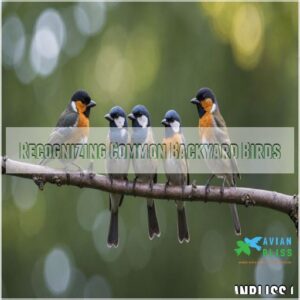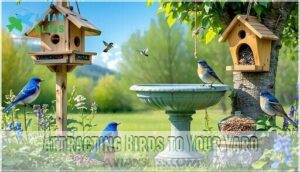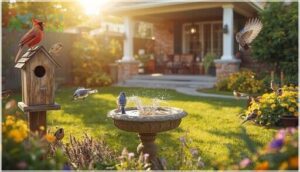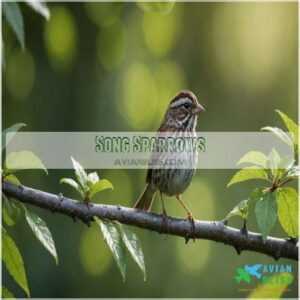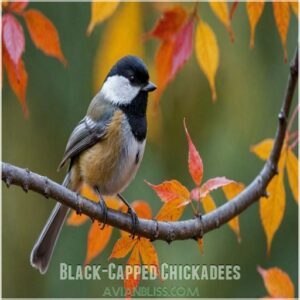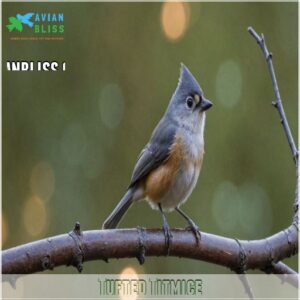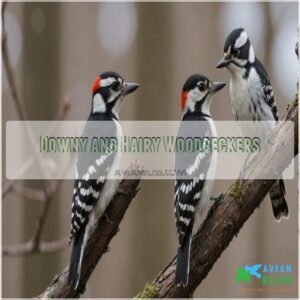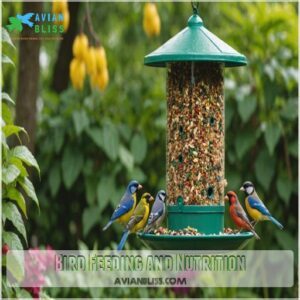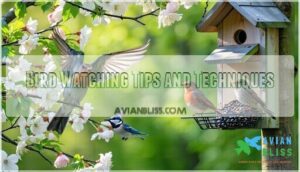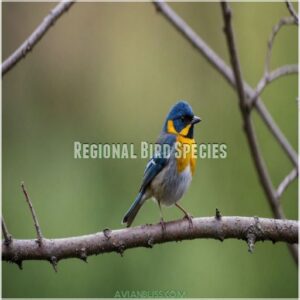This site is supported by our readers. We may earn a commission, at no cost to you, if you purchase through links.
 Spotting common backyard birds can feel like finding hidden treasures in your own garden.
Spotting common backyard birds can feel like finding hidden treasures in your own garden.
Look for Northern Cardinals with their striking red feathers and black masks.
American Robins charm with reddish-orange breasts and cheerful songs.
You might hear the jays before you see their flashy blue feathers and crests.
Mourning Doves, with gentle coos and plump bodies, offer a soothing presence.
Attract these flying gems by setting up sunflower seeds, suet feeders, and bird-friendly plants.
It’s like hosting a backyard party, only your guests have feathers!
Intrigued? There’s a lot more to uncover about these fascinating visitors.
Table Of Contents
- Key Takeaways
- Recognizing Common Backyard Birds
- Attracting Birds to Your Yard
- Understanding Bird Behavior
- Bird-Friendly Plants and Trees
- Creating a Bird-Friendly Environment
- Common Backyard Bird Species
- Bird Feeding and Nutrition
- Bird Health and Safety
- Bird Watching Tips and Techniques
- Regional Bird Species
- Frequently Asked Questions (FAQs)
- How many birds are in your backyard?
- What birds live in backyards?
- What are the best birds to see in your backyard?
- What are the most common backyard birds in Virginia?
- How do I identify a bird in my backyard?
- What is the most common garden birds?
- What birds can I attract to my yard?
- What is the Ohio bird?
- How long do backyard birds live?
- What are birds favorite foods?
- Do birds migrate in my area?
- How can I identify bird nests?
- What are common bird diseases?
- Conclusion
Key Takeaways
- You’ll spot vibrant Northern Cardinals, American Robins, and Blue Jays in your backyard, each with distinct colors and songs that make birdwatching a delight.
- Attract birds to your yard by offering sunflower seeds, suet, and fresh fruits from Alabama bird-friendly flora like native plants and trees, such as those found in guides for attracting backyard birds of alabama, and enhance your garden with bird-friendly plants and trees.
- Create a bird-friendly environment with birdbaths, nesting boxes, and reduced pesticide use to provide a safe haven for your feathered friends.
- Understand bird behavior by observing feeding habits, mating rituals, and social interactions, which can enrich your birdwatching experience.
Recognizing Common Backyard Birds
Spotting common backyard birds like Northern Cardinals, American Robins, Blue Jays, and Mourning Doves can be as exciting as a treasure hunt in your own backyard.
You’ll soon recognize their distinct colors and calls, making each encounter feel like a small victory in your birdwatching journey.
Identifying Northern Cardinals
Spotting a Northern Cardinal is like spotting a fiery-red jewel in the green backstage of your garden!
Here’s how to start your bird identification journey:
- Cardinal Identification: Look for bright red feathers and a distinctive black mask.
- Cardinal Calls: Listen for their whistling song.
- Cardinal Diet: Watch as they munch on sunflower seeds.
- Cardinal Habitat: Spot them in dense thickets.
Recognizing American Robins
Several key features help you identify American Robins.
They’re common backyard birds, easily recognized by their reddish-orange breasts.
Here’s a handy guide:
| Feature | Description | Habitat | Diet |
|---|---|---|---|
| Breast Color | Reddish-orange | Lawns, fields | Earthworms, insects |
| Head & Back | Black | Woods, parks | Fruit, berries |
| Size | Medium-sized | Robin habitat | Robin diet |
| Song | Cheerful, melodic chirps and whistles | Robin nesting sites | Robin migration patterns |
Their cheerful songs are a welcome sound in many robin habitats.
Distinguishing Blue Jays
When you’re exploring your backyard haven, recognizing the unmistakable Blue Jays becomes a real treat.
With their striking blue feathers and chatty behavior, they add charm to any garden.
Here’s what to look for:
- Crested Heads: Bold and beautiful.
- Blue Jay Calls: Mimic a hawk to scare!
- Unique Blue Jay Diet: Nuts and acorns are their delight.
Identifying Mourning Doves
Blue Jays might catch your eye with their bold colors, but mourning doves capture the heart with their soothing dove calls and elegant flight.
Larger than most songbirds, they’re recognizable by their plump bodies and gentle coos.
Check out these soft-brown beauties as they forage in your backyard, adding peaceful grace to your bird list.
| Dove Trait | Description | Fun Fact |
|---|---|---|
| Size | Larger plump bodies | Often misidentified as pigeons |
| Calls | Sweet, melancholy cooing | Sounds like an owl to some |
| Habitat | Backyards, grasslands | Found across all 48 lower states |
| Diet | Seed eaters | Love millet on ground/feeder |
Attracting Birds to Your Yard
Bringing birds to your yard is as easy as offering some of their favorite treats—sunflower seeds or suet feeders will do the trick.
Just remember, even a banana-loving bird might turn up its beak—so mix it up with fresh fruits and a hummingbird-friendly environment for a real avian paradise!
Using Sunflower Seeds
Noticing vibrant Northern Cardinals in your yard adds magic to your day.
Using sunflower seeds can invite these beauties and others, like Black-capped Chickadees.
Opt for unique seed types and store them properly to avoid spoilage.
Tailor the seed mix to bird preferences.
Equipped with the right feeder types, your backyard transforms into a delightful wildlife show.
Offering Suet Feeders
Suet feeders, which are a great fit with a bird-friendly landscaping approach, are a delightful way to attract birds to your yard, especially in winter.
Birds like woodpeckers and chickadees will flock to your suet, gaining essential nutrients.
Consider these tips:
- Suet feeder types: Choose cage or log styles.
- Placement: Hang them high and safe.
- Recipe variations: Mix seeds, nuts, and berries.
Keep your feathered friends happy!
Providing Fresh Fruits
While you’re mastering suet feeder placement, consider enhancing your backyard habitat with fresh fruits, such as grapes in moderation, which are a safe treat for most birds when seeds and peels are removed (learn more about grapes for birds).
Opt for seasonal fruits and safe feeders to suit their fruit preferences.
Bird-friendly trees like serviceberry or crabapple can increase biodiversity and attract more wildlife.
Enjoy the sight of feathered friends munching on these natural snacks, adding color and life to your yard.
Creating a Hummingbird-Friendly Environment
Want to attract hummingbirds? It’s easier than you think! Besides offering sugary treats, consider these hummingbird-friendly additions to your yard:
- Hummingbird feeders filled with nectar recipes.
- Native plants providing natural nectar sources.
- Shallow water features for bathing.
- Consider hummingbird migration patterns when planting. These tiny dynamos will thank you!
Understanding Bird Behavior
When you understand bird behavior, you’ll see your backyard in a whole new light, from the frantic feeding antics of sparrows to the majestic migration of robins.
Observing their quirky social interactions can be as entertaining as a soap opera, with plenty of drama, intrigue, and the always-important pecking order.
Feeding Habits of Common Backyard Birds
Birds have diverse feeding habits that’ll keep you fascinated.
Mourning doves might munch on seeds, while black-capped chickadees prefer sunflower seeds.
Blue jays go for acorns during seasonal changes.
It’s fun to notice how tufted titmice hoard food for winter.
To attract a variety of birds, setting up multiple feeders filled with quality seeds, nuts, and fruits using bird feeders and squirrel-proof feeders, can really make a difference in their visit frequency. Consider different feeder types to attract various backyard birds of the USA and Canada, and enjoy endless avian antics.
Breeding and Mating Habits
In the springtime, you’ll notice backyard birds engaging in energetic courtship rituals, from the melodic songs of native birds to the intricate dances of the mating season.
These displays lead to nesting, egg-laying, and diligent parental care.
Watching a sparrow’s nest-building is like witnessing nature’s own DIY project.
Through bird conservation efforts, you’re not just observing—you’re actively contributing to their thriving habitat.
Migration Patterns
As you witness the fluttering energy of migration timing, it’s like nature’s grand parade.
Birds heed seasonal changes, tracing age-old bird migration routes with precision.
Migration challenges? They’re just part of the journey!
Thanks to bird tracking technology, understanding these feats lets you marvel at bird diversity and nurture a vibrant backyard ecosystem that welcomes these seasonal visitors with open arms.
Social Interactions Among Birds
While understanding migration lets you track journeys, it’s the social side of birds that’s truly fascinating.
Imagine this: flocks maneuvering like aerial ballet dancers.
Observe these interactions:
- Bird hierarchies: Discover who’s boss.
- Flock dynamics: Watch how they team up.
- Mating rituals: Spot the dance of wooing.
- Territorial disputes: Guarantee peace through strategic planning.
Use a bird identification guide to decode their complex behaviors!
Bird-Friendly Plants and Trees
To attract a colorful array of birds to your yard, consider planting native species that offer food and shelter, like berry-producing shrubs and sturdy trees.
These additions create a welcoming habitat for your feathered friends,
but they also help you enjoy the cheerful sights and sounds without needing to leave your backyard.
Native Plants for Attracting Hummingbirds
Many vibrant native plants attract hummingbirds to your hummingbird-friendly garden!
Choose regional hummingbird plants; this makes sure they thrive.
Look for tubular flowers, offering nectar rewards.
Bee balm and trumpet honeysuckle are excellent choices.
Planting these beauties boosts native plant benefits, creating a haven for these amazing birds.
It’s birdwatching for beginners, too—easy to identify birds by sight!
Trees for Providing Shelter
Imagine your backyard as a bird’s paradise with trees that shelter.
Different tree types offer the perfect spot for bird nesting and winter protection.
Picture a cozy place for birdwatching, right in your neighborhood or city.
By creating a welcoming habitat, you’ll enjoy birdwatching tips and tricks come alive as feathered friends make their homes in your oasis.
Shrubs for Offering Berries
After ensuring your trees give cozy shelter, let’s focus on berry-bearing shrubs.
These are the magnets for hungry birds, inviting them with a feast right in your backyard.
By incorporating native plants and reducing pesticide use, you can create a bird-friendly habitat.
Choose native plants like elderberry or serviceberry, which enhance landscaping but also provide natural treats as part of a bird-friendly habitat.
Plus, they make birdwatching a thrill, especially for kids with apps or birdwatching websites.
Flowers for Attracting Pollinators
Harness your garden’s magic by planting flowers that attract pollinators, inviting a chorus of birds to your backyard.
Choose native flower types to naturally support local ecosystems.
Consider flower color impact; vibrant hues draw more pollinators.
To complement your bird-friendly garden, explore products for backyard birds at Backyard Bird Supplies.
Think about planting times for continuous blooms.
You’ll enjoy:
- Pollinator garden design
- Birdwatching delights
- Birdwatching photography opportunities
Your garden will be buzzing with life!
Creating a Bird-Friendly Environment
Creating a bird-friendly environment doesn’t require you to transform your yard into a forest sanctuary; simple steps like installing birdbaths, offering nesting boxes, and reducing pesticide use can make a big difference.
You’ll soon find that even a modest effort can attract a delightful array of feathered friends, all while enjoying the added bonus of free backyard entertainment.
Installing Birdbaths
Adding a birdbath adds a splash of excitement to your yard—literally!
Choose a level spot for your birdbath placement, ensuring nearby cover for bird safety.
Keep the water shallow and fresh by sticking to a regular cleaning schedule.
Various birdbath types suit different budgets and styles, making them perfect focal points for birdwatching and enhancing birdwatching photography tips.
Providing Nesting Boxes
While you’re installing birdbaths to refresh your feathered friends, consider setting up nesting boxes next.
You can find various options for birdhouses at birdhouse products online.
Pick sturdy nesting box materials and think about box placement, like facing away from harsh winds.
Regular box maintenance helps make a cozy home for birds.
Get creative with DIY nesting boxes—your backyard will be buzzing with interest from birdwatching enthusiasts and photographers alike!
Reducing Pesticide Use
Now that you’ve provided nesting boxes, let’s talk pesticides.
They’re harmful to birds, so opt for organic gardening methods.
Natural pest control, like ladybugs, is a bird-safe alternative.
Reducing pesticide use offers major environmental benefits.
Think of it as creating a haven, not a hazard zone!
Plus, healthy birds mean better birdwatching photography opportunities—join a local community or workshop!
Creating a Bird-Friendly Landscape
Consider reducing pesticides, not just for your lawn’s sake, but also to boost bird-friendly landscapes.
Create habitats that attract diverse bird species by featuring:
- Bird-friendly plants to provide nourishment.
- Nesting boxes for cozy homes.
- Water sources like birdbaths to quench thirst.
- Predator control to keep your feathered friends safe.
It’s like building a little avian paradise right in your backyard!
Common Backyard Bird Species
You’ll often see fascinating birds like song sparrows, black-capped chickadees, tufted titmice, and both downy and hairy woodpeckers gracing your backyard.
Each brings unique behaviors and calls, turning your yard into a delightful natural concert.
So grab a seat and enjoy the show!
Song Sparrows
Song Sparrows are surprisingly chatty and love to mix it up.
Their habitat stretches across yards, wetlands, and fields.
Identifying bird songs is a nifty skill, especially with their sweet, distinctive “chimp” calls.
Their nests are cozy, often tucked among grasses.
Focus on their diet, rich in seeds and insects, ensuring these songsters feel right at home.
Black-Capped Chickadees
A few black-capped chickadees can bring delight to your backyard birdwatching.
Their “chickadee-dee-dee” call is a cheerful background to your morning coffee.
Known for their chickadee intelligence and curious nature, they readily eat sunflower seeds.
These clever birds remember feeder locations, even during harsh winters, making them regular guests.
Share your chickadee moments in birdwatching photography blogs and clubs.
Tufted Titmice
After admiring the cheerful Black-Capped Chickadees, watch for the busy Tufted Titmice.
These charming birds, with their tufted crests and lively antics, are frequent visitors across North America.
Listen for their distinct calls and observe their quirky food hoarding behavior, which helps them survive harsh winters.
Perfect subjects for birdwatching photography, they bring a touch of whimsy to your backyard.
Downy and Hairy Woodpeckers
If you’ve marveled at the Tufted Titmice‘s antics, get ready to be charmed by the Downy and Hairy Woodpeckers.
Sporting snazzy black and white outfits with splashes of red, these birds are suet lovers.
They keep busy drumming on trees, a delightful sound that echoes through your yard.
To tell them apart, look for key differences in their woodpecker identification.
Spotting their beaks, with the Downy having a smaller one, makes identification easy.
Bird Feeding and Nutrition
Providing the right food is key to attracting a variety of birds.
Consider different feeder types and the nutritional needs of your local species.
Ensure you’re offering a balanced and delicious menu for your feathered friends.
Types of Bird Feeders
You’ve got a variety of bird feeder options to tickle your feathered friends’ fancy.
Choosing the right one is key, as different bird feeder types can attract specific birds.
Platform feeders welcome many birds, while tube feeders are great for smaller seeds.
Hopper feeders, looking like cute little houses, store food well, and suet feeders offer rich treats.
Finally, ground feeders cater to birds that prefer dining close to Earth.
Choose wisely for happy chirping!
Choosing The Right Bird Food
Birdseed selection is like crafting a perfect menu for your feathered friends.
Opt for sunflower seeds to attract a variety, or try millet for ground feeders like mourning doves.
Use quality storage to keep seeds fresh, and adjust your offerings seasonally—think rich suet mixes in winter.
Experiment with DIY mixes to satisfy your backyard’s diverse avian appetites.
Providing Fresh Water
Choosing the right bird food is key, but don’t forget to quench their thirst.
Fresh water sources bring in the feathered friends just like seed buffets.
For a splash-worthy setup, consider:
- Bird baths – Shallow and safe.
- Water features – Add movement.
- Quality checks – Keep it clean.
- Placement – Safe but visible.
Birds will thank you!
Avoiding Overfeeding
Finding just the right birdbath placement can be tricky, but overfilling feeders isn’t.
Keeping portions in check guarantees bird health, minimizes waste, and prevents clutter around feeders.
Balance is key!
| Consider | Tip |
|---|---|
| Feeder Size | Choose small feeders |
| Food Storage | Store seeds in a cool, dry place |
| Feeder Placement | Keep away from windows |
| Bird Health Risks | Check for moldy seeds regularly |
Bird Health and Safety
Ensuring the health and safety of your backyard birds can feel a bit like being their guardian angel, but it’s quite rewarding!
By taking steps to prevent window collisions and protect them from predators, you’re giving birds a safer environment and creating an avian paradise right outside your window.
Common Bird Diseases
Common bird diseases can really ruffle your feathers if you’re not careful.
From avian pox to salmonellosis, these ailments pose significant threats to our feathered friends.
Keep feeders clean and avoid overcrowding to prevent outbreaks.
If you spot sick birds, reach out to local wildlife rehab centers for treatment options.
Your backyard can remain a vibrant, healthy paradise for all your avian visitors!
Preventing Window Collisions
Keeping your feathered friends safe is important. Sadly, windows can be deadly for birds. To prevent collisions, consider these simple solutions: Use window decals, or install bird-safe glass. Reflective surfaces also help. Remember, even small changes in your home design can make a big difference.
- Place bird feeders away from windows.
- Use patterned window film.
- Hang streamers or other decorations near windows.
- Keep curtains or blinds closed during peak bird activity hours.
Protecting Birds From Predators
Worried about predators snatching your feathered friends?
First, think like a bird and install cat-proof feeders – they turn feline sneak attacks into a tough challenge.
Try predator-safe landscaping; thorny bushes are effective bouncers!
Don’t forget bird-friendly windows to avoid accidental fly-ins, and choose smart nesting box placement.
Creating a Safe Bird Environment
To keep birds safe, while predator prevention is top of mind, focus next on a sanctuary for your feathered friends.
Install bird-safe windows to prevent accidental collisions.
Embrace habitat diversity by adding plants that offer shelter.
Make sure they’ve clean water sources and maintain feeder hygiene—pure bliss for the birds and peace of mind for you!
Bird Watching Tips and Techniques
When you’re bird watching, choosing the right binoculars is like finding the perfect pair of glasses—it helps you see every feather and flutter with clarity.
To make your experience even more rewarding, try identifying birds by their songs and scribbling observations in a bird journal, which will make you feel like the Sherlock Holmes of birding.
Choosing The Right Binoculars
After ensuring your backyard’s a safe haven, let’s boost your birdwatching skills with the right binoculars.
Pick ones that feel good in your hands and suit your budget.
Remember:
- Binocular size: Compact ones are easier to carry.
- Magnification level: 8x is a popular choice.
- Lens quality: Look for good clarity and brightness.
Spotting birds will be a breeze!
Identifying Birds by Song
Got your binoculars ready? Great! Now, shift your focus to identifying birds by song.
Learning bird calls is easier with the right tools, such as products available for bird identification kits.
Bird calls are nature’s unique playlist.
From the sweet notes of the Song Sparrow to the mimicry of the Northern Mockingbird, you can start by using sound recordings and Bird ID apps.
With practice, you’ll spot song variations that make each bird a distinct melody in your yard.
Observing Bird Behavior
Identifying birds by song sharpens your ears and sets the stage for observing their behavior, which includes complex vocalizations like songs and calls for communication.
Spotting birds in action is like being front row at nature’s theater.
Watch for these:
- Territorial displays—it’s like cheering for a sports team!
- Nesting behavior with materials flying.
- Flocking behavior of social birds.
- Daily routines during feeding and resting.
Enjoy the show!
Keeping a Bird Journal
Start a bird journal to track your sightings!
Along with noting bird species, carefully record their behavior.
Did you see unusual bird feeding patterns?
Document everything – date, time, location, and even weather conditions.
This detailed record helps you monitor bird population trends and improve your bird identification tips over time.
It’s like having your own personal field guide!
Plus, you’ll develop a deeper understanding of these feathered friends.
Regional Bird Species
Exploring regional bird species in your area brings the joy of discovering unique feathered friends specific to different U.S. landscapes.
Whether you’re in the bustling Northeast or the sun-drenched South, each region offers a delightful variety of birds that can transform your backyard into a vibrant aviary.
Common Backyard Birds in The Northeast
As you tune your ear to birdsongs, you’ll spot fantastic backyard birds in the Northeast.
Watch for the striking red of a Northern Cardinal or the cheerful tinkling of a Song Sparrow.
Your bird feeders will become prime real estate during winter survival.
To properly identify birds, familiarize yourself with their distinct calls using bird call apps or recordings, such as those found in resources about backyard birds of illinois. Be mindful of backyard predators and note nesting habits for proper bird identification.
- Northern Cardinals
- Song Sparrows
- American Goldfinches
- Black-capped Chickadees
- Tufted Titmice
Common Backyard Birds in The Midwest
Imagine watching black-capped chickadees and tufted titmice flit about your Midwest backyard, each one adding charm to your mornings.
With Midwest bird feeders stocked with sunflower seeds, you’ll support their winter survival.
As seasons change, these lively visitors adapt, finding their way through bird migration and enriching your backyard habitat with delightful avian company.
Keep your binoculars handy!
Common Backyard Birds in The South
On a sunny Southern afternoon, spy the vibrant Northern Cardinals or the cheeky Blue Jays.
Similar to Alaskan bird species, such as the Black-capped Chickadee that thrives on seeds and suet sources, with a sprinkle of sunflower seeds, you’ll attract these Southern bird species right to your yard.
Winter feeding keeps them around during colder months.
For enthusiasts, bird identification becomes a delightful challenge.
Transform your backyard landscaping into a paradise with native plants, inviting hummingbirds’ dazzling dances.
Common Backyard Birds in The West
You know, the West boasts some mesmerizing avian characters you can’t miss.
Imagine this:
- Steller’s Jays with their bold blue bodies
- Rufous Hummingbirds dazzling with their fiery plumage
- Black-billed Magpies strutting with long tails
- Spotted Towhees scratching under shrubs
These western wonders adapt to drought and migration.
Place feeders thoughtfully, and you’ll have a lively yard!
Frequently Asked Questions (FAQs)
How many birds are in your backyard?
Tallying the birds in your backyard can be like counting stars—challenging, but thrilling!
Grab binoculars, sketch their quirks, and spot common ones like cardinals or chickadees.
Remember, bird-watching is about patience and enjoying nature’s wonders.
What birds live in backyards?
Picture your backyard: a bustling playground for Northern Cardinals, lively Blue Jays, or soft-cooing Mourning Doves.
They’re like your feathered neighbors, just hanging around.
With their colorful feathers and spirited songs, these birds make every day brighter.
What are the best birds to see in your backyard?
Catch sight of vibrant Northern Cardinals, curious Blue Jays, and gentle Mourning Doves in your backyard.
These birds bring joy and color, playing like feathered gardeners, maintaining a cheerful melody while entertaining with their unique behaviors.
What are the most common backyard birds in Virginia?
Imagine bright cardinals flitting among flowers while melodic robins sing from tree branches.
In Virginia, you’ll often spot cheerful blue jays, adept woodpeckers drumming trees, and sociable chickadees at feeders, creating a lively backyard bird scene.
How do I identify a bird in my backyard?
Watch your bird’s behavior, listen for calls, and note its colors and size.
Compare these details with a field guide or app.
Chat with birding friends to confirm your ID.
Patience and observation work wonders!
What is the most common garden birds?
In your garden, you’ll typically spot cheerful sparrows, vivid Northern Cardinals, chatty Blue Jays, and curious American Robins.
Each bird thrives in different spots, feeding and singing, adding joy and life to your outdoor haven.
What birds can I attract to my yard?
You can attract birds by providing food like seeds and suet, and water sources.
Planting native shrubs and trees also helps!
Consider a bird bath; they love a good soak.
Enjoy your feathered friends!
What is the Ohio bird?
Ohio’s official bird is the Northern Cardinal.
With its striking red feathers and cheerful song, this bird adds a splash of color to Ohio landscapes.
Cardinals are easy to spot and beloved for their vibrant presence.
How long do backyard birds live?
Did you know many backyard birds can live over ten years?
Species like the American Robin, enjoy long lives with good care and habitat.
Give them clean feeders and water; they’ll reward you with endless joy!
What are birds favorite foods?
Birds, like us, have their favorite snacks.
Sunflower seeds, peanuts, fruits, and mealworms top the list.
Mourning doves, for example, love millet, while finches enjoy thistle seeds.
It’s about knowing your guests to serve the best!
Do birds migrate in my area?
Many birds around you migrate seasonally.
Warblers, sparrows, and hummingbirds often travel long distances to find the best food and climate.
It’s like their version of snowbird retirement, heading south when it gets chilly!
How can I identify bird nests?
Basically, identifying bird nests involves Sherlock-style observation of location, materials, and structure.
Watch for clues like leaf types, twig arrangements, siting in trees or shrubs, and size, offering clear hints about the bird builders.
What are common bird diseases?
You might encounter avian diseases like salmonella, avian pox, or conjunctivitis while watching birds.
These illnesses can spread quickly through feeders.
Regularly clean feeders and keep an eye on your feathered friends for any symptoms.
Conclusion
So, you’ve learned how to identify and attract common backyard birds.
Remember, providing food and water is key.
But don’t forget shelter!
A bird-friendly yard is a haven for these feathered friends.
Think of it as your own personal nature reserve, teeming with life.
You’ll soon be amazed by the variety of common backyard birds visiting your space.
It’s a rewarding hobby, and you’ll quickly become an expert on your local avian population.
Happy birdwatching!

